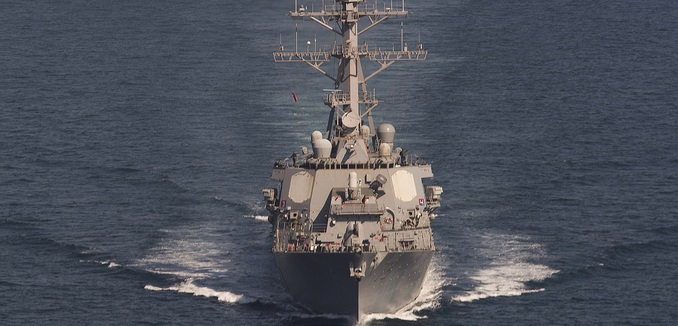A United States Navy destroyer fired on four smaller Iranian vessels in the Persian Gulf’s strategic Straits of Hormuz on Sunday after the smaller crafts approached at an unsafe speed and engaged in behavior that a Pentagon spokesman called “harassing.”
The Iranian ships, at least one of which had a sailor manning a gun, were a little more than half a mile away from the USS Mahan when the Mahan fired three warning shots. The Mahan had tried to contact the Iranian vessels and get them to change course before firing the shots, to no avail. After the shots were fired, the Iranian boats changed course.
“Naval Forces Central Command assesses this interaction as unsafe and unprofessional due to the IRGCN’s [Islamic Revolutionary Guard Corps Navy] vessels high-speed approach on Mahan with weapons manned and disregard for repeated warnings via radio, audible siren, and ship’s whistle, which only arrested following warning shots being fired,” Central Command spokesman Cmdr. Bill Urban said in a statement. Pentagon spokesman Capt. Jeff Davis added in his daily press conference on Monday that the event “was an unsafe and unprofessional interaction.”
A similar incident occurred in August, when the USS Squall was forced to fire on an Iranian ship that had come within 200 yards. Earlier that month, the USS Nitze had been harassed by four Iranian boats and was forced to fire flares to warn the approaching craft away. A video of that encounter is embedded below.
The Mahan incident is the latest Iranian challenge to America’s naval presence in the Persian Gulf and its commitment to keep the area open to international shipping. The IRGCN captured ten American sailors and two boats a year ago, an incident that Secretary of Defense Ashton Carter called “outrageous, unprofessional and inconsistent with international law” during a Senate hearing in March. Chief of Naval Operations Adm. John Richardson echoed Carter’s assessment while announcing the result of the Navy’s investigation into the seizure in June 2016. “Those boats and crewmembers had every right to be where they were that day,” Richardson said. “The investigation concluded that Iran violated international law by impeding the boats’ innocent passage transit, and they violated our sovereign immunity by boarding, searching, and seizing the boats, and by photographing and video recording the crew.”
The U.S. Navy reported last July that the year 2015 contained close to 300 encounters or “interactions” between American and Iranian naval vessels in the Persian Gulf. While most of the encounters were not considered to be harassment, the behavior of the Iranian navy was found to be less disciplined than that of other navies. Lt. Forrest Griggs, the operations officer of the USS New Orleans, explained that risks arise from the unpredictable behavior and uncertain intent of the Iranian vessels. “It’s very common for them to come up to within 300, 500 yards of us, and then they’ll turn, or parallel us and stop,” he said.
In December 2015, an IRGC boat fired rockets within 1,500 yards of the USS Harry S Truman, an action that was termed “highly provocative” by U.S. Central Command spokesman Cmdr. Kyle Raines. In April 2015, Iran seized the Marshall Islands-flagged Maersk Tigris and held it for ten days in violation of international law. The next month, Iranian vessels fired on a Singapore-flagged cargo ship after it refused to sail into Iranian waters, desisting only after the United Arab Emirates dispatched coast guard boats to help the distressed ship.
An Iranian surveillance aircraft came unusually close to a Navy helicopter from the USS Carl Vinson in March 2015, a month after the IRGCN sunk a mock U.S. aircraft carrier during military exercises. The exercises were broadcast on state television with a quote attributed to the first leader of the Islamic Republic, Ayatollah Ruhollah Khomeini: “If the Americans are ready to be buried at the bottom of the waters of the Persian Gulf – so be it.” A year before, Iran broadcast a simulation of its forces attacking Israel and the American aircraft carrier USS Abraham Lincoln on state television.
Vice Admiral Kevin Donegan, the commander of the U.S. Navy’s Fifth Fleet, observed in November 2015 that Iran’s “malign behavior” at sea had not changed since the announcement of the nuclear deal four months earlier.
[Photo: U.S. Naval Forces Central Command/U.S. Fifth Fleet / Flickr ]




